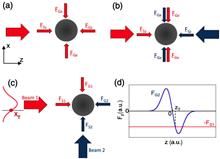Cholesteric liquid crystals, consisting of chiral molecules, form self-assembled periodic structures exhibiting a photonic bandgap. Their selective reflectivity makes them well suited for a variety of applications; their optical response is therefore of considerable interest. The reflectance and transmittance of finite cholesteric cells is usually calculated numerically. Evanescent modes in the bandgap make the calculations challenging; existing matrix propagation methods cannot describe the reflection and transmission coefficients of thick cholesteric cells accurately. Here we present analytic solutions for the electromagnetic fields in cholesteric cells of finite thickness, and use them to calculate the transmission and reflection spectra. The use of analytic solutions allows for the accurate description of arbitrarily thick cholesteric cells, which would not be possible with only direct numerical methods.
We briefly review the development of gain-switched rare-earth-doped fiber lasers and their applications in wavelength conversion to mid-IR, supercontinuum generation, and medicine in recent years. We illustrate the similarities between gain-switching and Q-switching techniques that will provide tools for the design and optimization of the gain-switched fiber lasers. From the nature of the gain-switched fiber lasers, benefits of this kind of lasers to 2-μm region and in-band-pumped (two-level system) laser systems are obvious. Advantages of in-band-pumped 2-μm lasers are discussed and analyzed with a simple numerical simulation in terms of Tm-doped fiber lasers. We also propose the key factors in the development of the gain-switched fiber lasers and predict the future tendency.
We analyze the properties of a dual-beamtrap of orthogonally intersecting beams in the geometrical optics regime. We derive analytical expressions for the trapping location and stability criteria for trapping a microparticle with uncollimated Gaussian beams. An upper limit for the beam waist is found. Optical forces and particle trajectories are calculated numerically for the realistic case of a microparticle in intersecting liquid-core waveguides.












